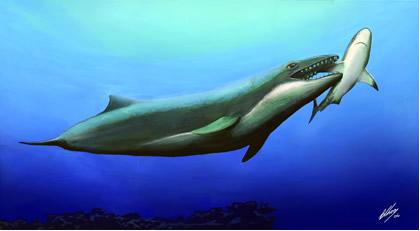A 25-million-year-old whale fossil from southeastern Australia has revealed a bizarre early type of 'baleen' whale. The creature was an ancient cousin of our modern blue whales and humpbacks, but it was hardly a gentle giant of the sea. Instead it was small and predatory, with enormous eyes and teeth.
 Artist's impression of the early toothed baleen whale.Brian Choo, Museum of Victoria
Artist's impression of the early toothed baleen whale.Brian Choo, Museum of VictoriaEnormous blue whales and humpbacks fall into the category of baleen whales (Mysticeti), which have no teeth, feeding instead by filtering out krill and plankton from huge gulps of sea water. For filters, the whales use large whalebone or 'baleen' plates arranged in comb-like rows on their jaws. Blue whales can grow up to 30 metres in length.
“It's almost like a whale from outer space.”
Erich Fitzgerald
Monash University, Australia
But the fossil relative of these whales, Janjucetus hunderi, discovered in Jan Juc, Victoria, looks quite different. "It's almost like a whale from outer space: truly weird," says study author Erich Fitzgerald of Monash University in Clayton, Australia. "In overall appearance and lifestyle, it looks more like a modern leopard seal." The skull is just 50 centimetres long, meaning that the whale would be no larger than a bottle-nosed dolphin. The snout is foreshortened, quite unlike the surfboard-like elongated snouts of modern whales, which have adapted to increase their surface area for filter feeding. And the eye sockets are enormous relative to the whale's size.
Furthermore, Janjucetus has large sharp teeth but no baleen. Considering its shape and large eyes (providing good underwater vision), it looks as though this whale was a predator that ate large fish — possibly sharks and other whales, Fitzgerald speculates.
Toothless, but toothed?
 Click here to see the whale family tree.R. Start, Museum of Victoria
Click here to see the whale family tree.R. Start, Museum of VictoriaHow, in that case, does Janjucetus count as a baleen whale? According to Fitzgerald, there are specialized features in the fossil whale's anatomy - where the snout meets the brain case, and at the base of the skull near the ear region — that are unique to baleen whales. And Janjucetus can't echolocate, a defining feature of modern toothed whales, such as sperm whales and dolphins.
The fossil was discovered by a teenager in the late 1990s, and fortunately was stored in Museum Victoria, Melbourne. There it languished, unstudied, until Fitzgerald found out about it in 2003. It took another three years to remove the fossil from the mudstone that encased it.
Janjucetus throws new light on the evolution of baleen whales. Such whales were already known to have originated from toothed whales; modern baleen whales go through a stage as embryos in which they have teeth. But there is a blank period in the fossil record between ancient toothed whales that lived 34 million years ago, and a profusion of various lineages of whale and dolphin — including baleen whales — that came into being around 25 million years ago.
ADVERTISEMENT
It had been assumed that when this explosion of whale specialization happened, baleen whales all took the path of toothless filter feeders. The fact that this toothed whale lived alongside them contradicts this idea.
But the concept of a toothed baleen whale didn't really catch on. This species was in an evolutionary cul-de-sac that subsequently died out, whereas the sharks it may have fed upon have survived to the modern day.
Visit our whaletruly_weird.html">newsblog to read and post comments about this story.
Monash University, Australia
